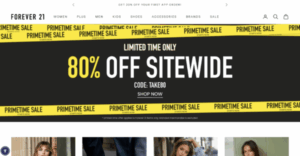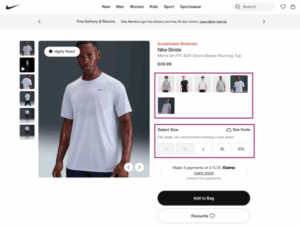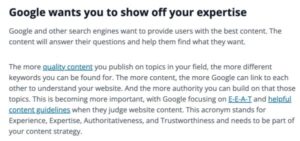Ecommerce mistakes are as common as shopping carts filled to the brim during a Black Friday sale. Why is that, you ask? Well, the ecommerce world is complex. It’s easy for online retailers to trip over unexpected — but also quite common — hurdles. But fear not! Identifying and correcting these technical SEO mistakes helps turn your online store into a success story.
1. Poorly structured online stores
A well-organized site structure is fundamental for both user experience and SEO. It helps search engines crawl and index your site efficiently while guiding users seamlessly through your products and categories. Yet, many ecommerce retailers make the mistake of using very complex site structures.
Common issues:
- Inconsistent URL structures: URLs that lack a clear hierarchy or use random character strings can confuse users and search engines.
- Lack of breadcrumbs: Without breadcrumbs, users might struggle to navigate back to previous categories or search results, leading to a frustrating user experience.
- Ineffective internal linking: Poor internal linking can prevent search engines from understanding the relationship between pages and dilute the distribution of page authority.
Solutions:
- Organize URLs: Develop a clear and logical URL structure that reflects your site hierarchy. For example, use
/category/subcategory/product-nameinstead of non-descriptive strings. This structure helps search engines understand the importance and context of each page. - Implement breadcrumbs: Breadcrumb navigation provides a secondary navigation aid, showing users their current location within the site hierarchy. Ensure breadcrumbs are visible on all pages and structured consistently.
- Optimize internal linking: Create a strategic internal linking plan to connect related products and categories. Use descriptive anchor text to improve keyword relevance effectively. Check 404 errors and fix these, if necessary.
More tips:
- Faceted navigation: If your site uses faceted navigation for filtering products, ensure it’s implemented to avoid creating duplicate content or excessive crawl paths. Use canonical tags or noindex directives where necessary.
- Site architecture depth: Keep your site architecture shallow, ideally allowing users and search engines to reach any page within as few clicks as possible from the homepage. This enhances crawlability and improves user experience.
- XML sitemaps: Regularly update your XML sitemap to reflect your site’s current structure and submit it to search engines. This ensures all important pages are indexed efficiently.
2. Ignoring mobile optimization
It seems strange to say this in 2024, but mobile is where it’s at. Today, if your online store isn’t optimized for mobile, you’re missing out on a big chunk of potential customers. Mobile shopping is not just a trend; it’s the norm. Remember, your customers are swiping, tapping, and buying on their phones — don’t make the mistake of focusing your ecommerce business on desktop users only.
Common issues:
- Slow mobile load times: Mobile users demand quick access to content. Slow-loading pages can drive potential customers away and negatively impact your performance.
- Poor user interface and user experience: A website design that doesn’t adapt well to mobile screens can make navigation difficult and frustrate users.
- Scaling issues: Websites that aren’t responsive can appear cluttered or require excessive zooming and scrolling on mobile devices.
Solutions:
- Responsive design: Ensure your website uses a responsive design that automatically adjusts the layout, images, and text to fit any screen size seamlessly.
- Optimize mobile performance: Improve load times by compressing images, minifying CSS and JavaScript files, and using asynchronous loading for scripts. Use tools like Google PageSpeed Insights to identify speed bottlenecks and fix mobile SEO.
- Improve navigation: Make your mobile navigation intuitive and easy to use. Consider implementing a fixed navigation bar for easy access and use clear, concise labels for menu items.
- Streamline the checkout process: Simplify the mobile checkout process by reducing the required fields, enabling auto-fill for forms, and providing multiple payment options such as digital wallets. Ensure that call-to-action buttons are prominently displayed and easy to tap.
- Test across devices: Regularly test your site on various devices and screen sizes to ensure a consistent and smooth user experience.
More tips:
- Leverage mobile-specific features: Use device-specific capabilities like geolocation to enhance user experience. For example, offer location-based services or promotions.
- Optimize images for mobile: Use responsive images that adjust in size depending on the device. Implement lazy loading so images only load when they appear in the viewport, improving initial load times.
3. Neglecting Schema structured data markup
Schema structured data markup is code that helps search engines understand the context of your content. Among other things, search engines use this to help display rich snippets in search results. Despite its benefits, many ecommerce sites underestimate its potential, missing out on enhanced visibility and click-through rates.
Common issues:
- Lack of implementation: Many ecommerce sites make the mistake of failing to implement schema markup, leaving potential enhancements in search results untapped.
- Incorrect or incomplete markup: When schema markup is applied incorrectly or not fully utilized, it can lead to missed opportunities for rich snippets.
- Overlooking updates: Schema standards and best practices evolve, and failing to update markup can result in outdated, incomplete, or ineffective data.
Solutions:
- Implement product schema: Use product schema markup to display key details such as price and availability directly in search results. This can make your listings more attractive and informative to potential customers.
- Utilize review and rating schema: Highlight customer reviews and ratings with schema markup to increase trust and engagement. Rich snippets featuring star ratings can significantly improve click-through rates.
- Add breadcrumb schema: Implement breadcrumb schema to enhance navigation paths in search results. This makes it easier for search engines to understand your site’s structure.
- Use structured data testing tools: Use Google’s Rich Results Test and Schema Markup Validator to ensure your markup is correctly implemented and eligible for rich results. Address any errors or warnings promptly.
More tips:
- Expand to additional schema types: Beyond product and review schema, consider using additional types relevant to your site, such as FAQ schema for common questions or product variant schema.
- JSON-LD format: Implement schema markup using JSON-LD format, which is Google’s recommended method. It’s easier to read and maintain, especially for complex data sets.
4. Inadequate page speed optimization
Page speed is critical to user experience and SEO. Google’s emphasis on Core Web Vitals and page experience underscores the importance of fast, smooth, and stable web experiences. Slow pages frustrate users and negatively impact SEO, which can reduce visibility and traffic.
Common issues:
- Large, unoptimized images: High-resolution images that aren’t compressed can significantly increase load times. This is one of the biggest and most common ecommerce mistakes.
- Render-blocking resources: CSS and JavaScript files that prevent a page from rendering quickly can delay visible content.
- Poor server response times: Slow server responses can delay the initial loading of a page, affecting LCP.
Solutions:
- Optimize images: Compress images using formats like WebP and utilize responsive image techniques to serve appropriately sized images for different devices.
- Eliminate render-blocking resources:
- Defer non-critical CSS: Load essential CSS inline for above-the-fold content and defer the rest.
- Async JavaScript: Use the
asyncattribute for scripts that can load asynchronously ordeferfor scripts that are not crucial for initial rendering.
- Improve server response times:
- Use a Content Delivery Network (CDN) to cache content closer to users.
- Optimize server performance by upgrading hosting plans, using faster DNS providers, and implementing HTTP/2 — or the upcoming HTTP/3 standard — for faster data transfer.
- Enhance Core Web Vitals:
- For LCP: Optimize server performance, prioritize loading of critical resources, and consider preloading key assets.
-
- For INP: Focus on minimizing CPU processing by running code asynchronously, breaking up long tasks, and ensuring the main thread is not blocked by heavy JavaScript execution.
-
- For CLS: Set explicit dimensions for images and ads, avoid inserting content above existing content, and ensure fonts load without causing layout shifts.
More tips:
- Lazy loading: This method delays the loading of off-screen images and videos until they are needed, reducing initial load times.
- Minimise HTTP requests: Reduce the number of requests by combining CSS and JavaScript files, using CSS sprites, and eliminating unnecessary plugins or widgets.
- Use browser caching: Implement caching policies to store static resources on users’ browsers, reducing load times for returning visitors.
5. Improper canonicalization
Canonicalization helps search engines understand the preferred version of a webpage when multiple versions exist. This is important for ecommerce sites, where similar or duplicate content is common due to variations in products, categories, and pagination. Improper canonicalization can lead to duplicate content issues.
Common issues:
- Duplicate content: Multiple URLs displaying the same or similar content can confuse search engines, leading to reduced performance.
- Product variations: Different URLs for product variations (e.g., size, color) can create duplicate content without proper canonical tags.
- Pagination: Paginated pages without canonical tags can lead to indexing issues.
Solutions:
- Use canonical tags: Implement canonical tags to specify the preferred version of a page. This tells search engines which URL to index and attribute full authority to, helping to consolidate ranking signals.
- Handle product variations: For product pages with variations, use canonical tags to point to the main product page.
- Optimize pagination: Link pages sequentially with clear, unique URLs (e.g., using “?page=n”) and avoid using URL fragment identifiers for pagination. Make sure that paginated URLs are not indexed if they include filters or alternative sort orders by using the “noindex” robots meta tag or robots.txt file.
More tips:
- Consistent URL structures: To minimize the potential for duplicate content, maintain a consistent URL structure across your site. Use descriptive, keyword-rich URLs that clearly convey the page’s content.
- Avoid session IDs in URLs: If your ecommerce platform uses session IDs, configure your system to avoid appending them to URLs, as this can create multiple versions of the same page.
- Monitor changes: Track any changes to your site architecture or content management system that could affect canonicalization.
6. Not using XML sitemaps and robots.txt effectively
XML sitemaps and robots.txt files help guide search engines through your ecommerce site. These tools ensure that search engines can efficiently crawl and index your pages. Missing or misconfigured files can lead to indexing issues, negatively impacting your site’s SEO performance.
Common issues:
- Incomplete or outdated XML sitemaps: Many sites fail to update their sitemaps, which excludes important pages from search engine indexing.
- Misconfigured robots.txt files: Incorrect directives in robots.txt files can inadvertently block search engines from accessing critical pages.
- Exclusion of important pages: Errors in these files can result in important pages, like product or category pages, being overlooked by search engines.
Solutions:
- Create and update XML sitemaps: Generate an XML sitemap that includes all relevant pages, such as product, category, and blog pages. Regularly update the sitemap to reflect new content or structure changes and submit it to search engines via tools like Google Search Console.
- Optimize robots.txt files: Ensure your robots.txt file includes directives to block irrelevant or duplicate pages (e.g., admin pages, filtering parameters) while allowing access to important sections. Use the file to guide crawlers efficiently through your site without wasting crawl budget.
- Use sitemap index files: For large ecommerce sites, consider using a sitemap index file to organize multiple sitemap files. This approach helps manage extensive product catalogs and ensures comprehensive coverage.
More tips:
- Dynamic sitemaps for ecommerce: Implement dynamic sitemaps that automatically update to reflect inventory changes, ensuring that new products are indexed quickly.
- Leverage hreflang in sitemaps: If your site targets multiple languages or regions, include hreflang annotations within your XML sitemaps to help search engines identify the correct version for each user.
7. Failing to optimize for international SEO
For ecommerce retailers targeting global markets, international SEO is crucial for reaching audiences in different countries and languages. A good international SEO strategy ensures your site is accessible and relevant to users worldwide. International ecommerce SEO is all about maximizing your global reach and sales potential — it would be a mistake to forget about this.
Common issues:
- Incorrect hreflang implementation: Misconfigured hreflang tags can display incorrect language versions to users, confusing search engines and visitors.
- Uniform content across regions: Using the same content for regions without localization can make your site less appealing to local audiences.
- Ignoring local search engines: Focusing solely on Google can mean missing out on significant portions of the market in countries where other search engines dominate.
Solutions:
- Implement hreflang tags correctly: Use hreflang tags to indicate language and regional targeting for your pages. This helps search engines serve users the correct language version. Ensure each hreflang tag references a self-referential URL and includes all language versions.
- Create region-specific content: Localize your content to reflect cultural nuances, currency, units of measure, and local terminology. This enhances user experience and increases relevance and engagement.
- Optimize for local search engines: Optimize your site according to their specific algorithms and requirements in markets where other search engines like Baidu (China) or Yandex (Russia) are prevalent.
- Use geotargeted URLs: Implement subdirectories (e.g., example.com/us, example.com/fr) or country-code top-level domains (ccTLDs) such as example.fr to effectively target specific countries.
More tips:
- Local backlinks: Build backlinks from local websites to improve visibility in specific regions. Set up local PR campaigns and partnerships to build credibility and authority.
- CDNs and server locations: Host your site on servers within your target market to improve load times and performance for users in that region.
- Structured data for local business: Use structured data markup to highlight local business information, such as location and contact details.
8. Not using Yoast SEO for Shopify
This is a bit of a sneaky addition, but number eight in this list of common ecommerce mistakes to avoid is not using Yoast SEO for Shopify or our WooCommerce SEO add-on. Both come with solutions for many of the common errors described in this article. Our tools make it easier to manage ecommerce SEO and Shopify SEO so you can focus on improving many other aspects of your online store. We provide a solid groundwork in a technical SEO sense and provide tools to improve your product content. We even have AI features that make this takes easier than ever.
Be sure to check out Yoast SEO for Shopify and WooCommerce SEO!
Common ecommerce mistakes to avoid
Regular technical audits and improvements are crucial if you want your online store to keep performing well. Addressing these technical issues helps ecommerce retailers improve search visibility, user experience, and conversion rates. Just be sure not to make these common ecommerce SEO mistakes again!
The post 7 common technical ecommerce SEO mistakes to prevent appeared first on Yoast.




